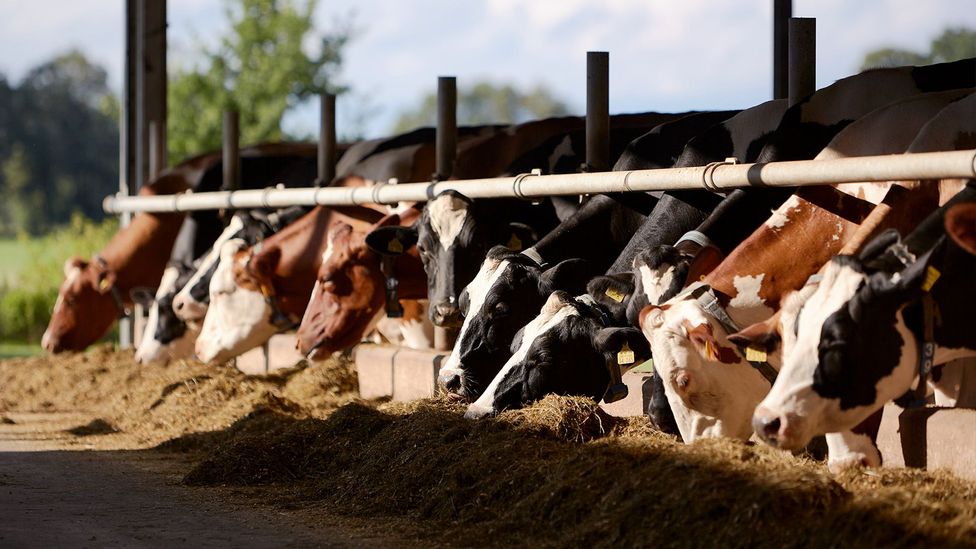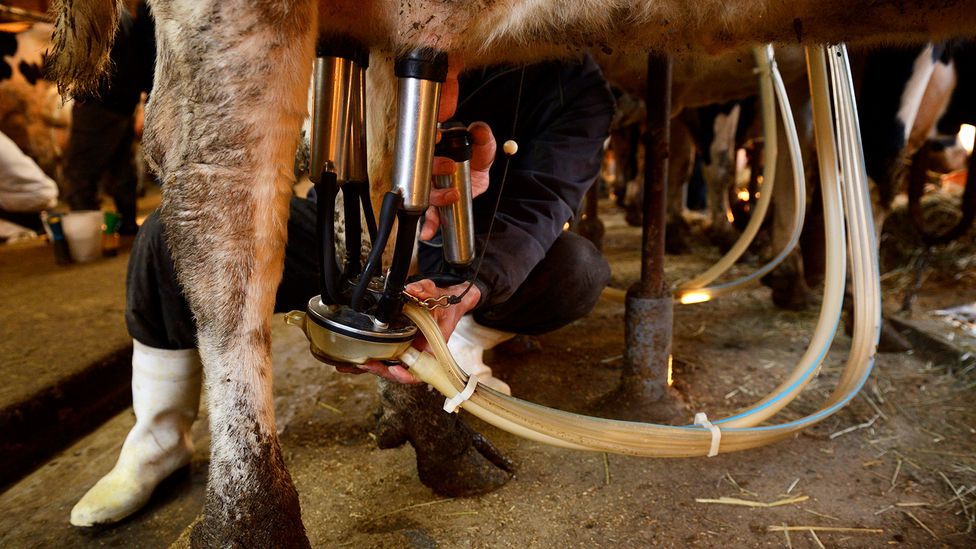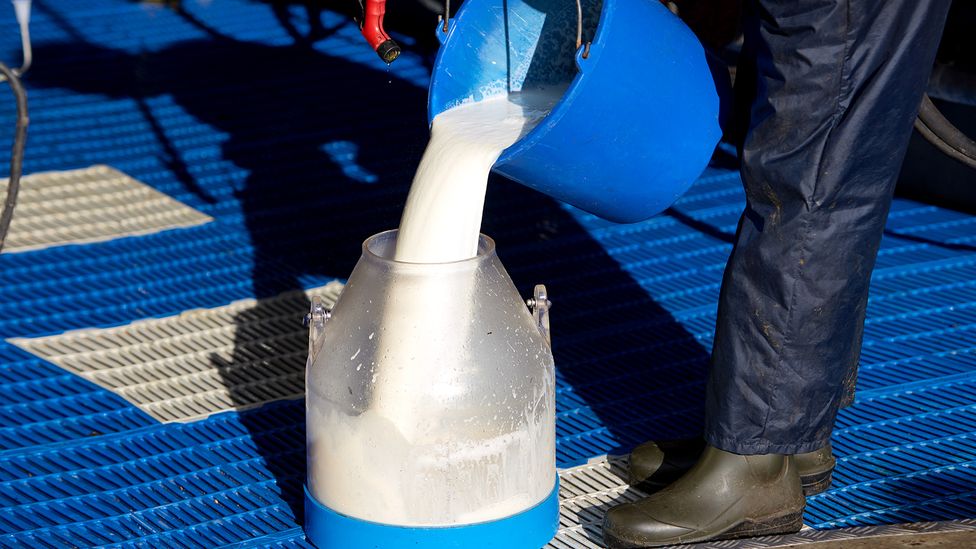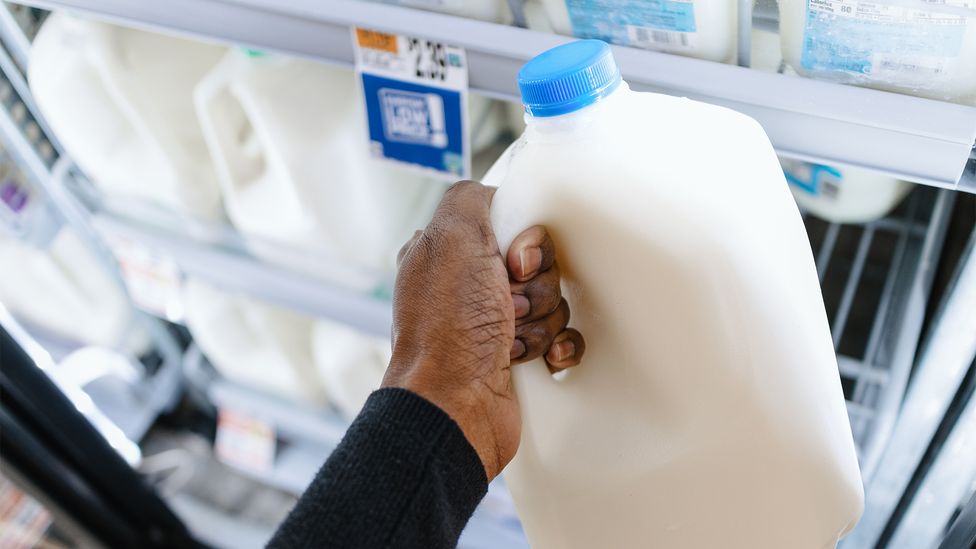An outbreak of avian influenza in American dairy cattle has shown no signs of slowing in recent weeks, with nine states reporting cows infected with the H5N1 virus. The virus does not typically jump from cows to humans, but in April a farm worker in Texas tested positive for bird flu.
Remnants of the bird flu virus (H5N1) have been found in 20% of pasteurised milk samples in the US. Pasteurisation is a heating process used to kill pathogens such as the H5N1 virus, leaving non-infectious, inactive fragments of the virus behind.
The majority of milk in the US is pasteurised, going through an intensive heating process which kills pathogens, such as H5N1. The Food and Drug Administration (FDA) strongly recommends against drinking raw milk.
Is pasteurised milk safe?In an initial study, the FDA tested 297 commercial dairy products from 38 states and detected high-pathogenic avian influenza (HPAI) viral particles in one in five samples. "This suggests that HPAI infection in dairy cows was more widespread than previously appreciated," the FDA wrote in its findings.
But as pasteurisation destroys viruses leaving broken remnants such as DNA or bits of the protein coat behind, the next step was to find out if these viral particles were active and infectious, or simply inactive fragments. The agency used egg inoculation tests to find out – the "gold standard for infectivity". These tests involve introducing the virus to an egg and incubating it there, to see if the virus reproduces.
The tests came back negative, indicating that there was no evidence of live H5N1 bird flu virus in the pasteurised milk. "This demonstrated conclusively that standard pasteurisation inactivates influence when raw milk is processed," the agency concluded.

Fragments of the bird flu virus has been found widely in dairy products in the US (Credit: Getty Images)
"The FDA has been working with deliberate speed on a wide range of studies looking at milk along all stages of production – on the farm, during processing, and on retail shelves – to inform our understanding of HPAI and its presence in milk," a spokesperson for the FDA tells the BBC. Based on this research, the spokesperson says the FDA is confident in the safety of the commercial pasteurised milk supply.
"Pasteurisation equals safety," Michael Payne, a researcher at the Western Institute of Food Safety and Security at the University of California, Davis, tells the BBC. "The science and technology of pasteurisation has been keeping people safe since the 1860s."
A 2020 study found all viruses, except parvoviruses, are "susceptible to thermal killing". Essentially, there are no risks from viruses in pasteurised milk, says Payne. "This is also true of dairy product made from pasteurised milk – butter, cream, etc."
But, Payne adds, bird flu in cattle is a "brand new disease presentation" and so researchers are scrambling to learn more about it.
"Two months ago, there were no dairy or food safety researchers who anticipated that we would be testing for avian influenza in the tissue or product of cows," Payne says. "Thus far, all of our laboratory and epidemiologic investigations indicate that it is extremely difficult for a cow to pass the virus to a human."
Cow-to-human infection
A recent, isolated case of human infection with bird flu in Texas involved a dairy farm employee working with cows presumed to be infected with H5N1.
The worker did not develop respiratory symptoms. However, they developed conjunctivitis with the virus present in the eye tissue, and reported not wearing eye protection when working with symptomatic cows. The worker's conjunctivitis cleared within days, and their household contacts remained well.
The virus has not spread easily between humans, though a few instances of limited transmission have been reported in the past decades.
To date, there have been no reported cases of a human contracting bird flu from raw milk. Only 27 states permit the sale of raw milk and it is illegal to sell raw milk across state lines.
However, raw milk can contain a variety of disease-causing pathogens, such as Listeria and E.coli.
On 29 April, the New York State Department of Agriculture and Markets issued an alert to residents of Schuyler County New York after one person became ill after drinking raw milk from a local dairy. The raw milk was found to be contaminated with Campylobacter, a bacteria that can cause diarrhoea, stomach cramps and fever.
These alerts are common, says Jeremy Luban, a molecular biologist at the University of Massachusetts who studies the interaction between human cells and deadly pathogens. Raw milk, by definition, does not go through any kind of heating process to pasteurise it.
With regard to bird flu specifically, it's too early to determine the risk, says Luban.
"It's hard to paint a broader picture because there is a lack of information," he says, referring to how the virus moves between species. "We've never seen anything like this before."
However, the potential presence of bird flu in milk has proven deadly to other animals. The Centre for Disease Control and Prevention (CDC) published a report on the death of several barn cats after consuming raw milk from infected cows. Out of 24 resident barn cats at one Texas dairy who were fed raw milk, half fell ill and died.
Eric Burrough, a pathologist at Iowa State University Veterinary Diagnostic Laboratory and author of the paper, notes that the milk was very high in HPAI, and the lab was able to grow live virus from the raw milk in that outbreak. "Numerous cats on other dairies also fed raw milk have developed disease and died," Burrough says.
Other pathogens found in raw milk have proved harmful to humans. A study analysing 121 outbreaks of foodborne illnesses in dairies between 1993 and 2006 found 60% involved non-pasteurised dairy products, which resulted in 202 people being hospitalised and two deaths.
"Because of the limited information available about the possible transmission of H5N1 virus via raw milk, the FDA continues to consider all ongoing scientific research related to HPAI in bovine milk," the FDA spokesperson says. "The FDA continues to advise strongly against the consumption of raw milk and recommends that industry does not manufacture or sell raw milk or raw milk products."
Raw milk popularityDespite the risks, a 2022 study found around 4.4% of people in the US reported drinking raw milk in the 12 months prior.
One 2014 study of 983 infants in Europe found that consumption of unprocessed cow's milk reduced risk of respiratory infections by around 30%. The authors did also note that raw milk was capable of transmitting serious infections including tuberculosis and brucellosis, among others.
"If the health hazards of raw milk could be overcome, the public health impact of minimally processed but pathogen-free milk might be enormous, given the high prevalence of respiratory infections in the first year of life," the authors concluded.
Another body of research from scientists in Germany found raw milk could reduce asthma and allergies. However, the study authors likewise noted the "minimal but real risk of life-threatening infections" from raw milk. (The researchers of this study declared receiving funding from the dairy company FrieslandCampina, and the infant formula manufacturer Mead Johnson Nutrition.) Other researchers argue vehemently that pasteurisation is essential to avoid serious health risks from contaminated milk.
An ongoing trial in Germany is comparing ultra-heat treated milk with other, less heat-intensive methods for ensuring milk is free of pathogens, to assess their effects in children with asthma.

Unpasteurised milk is more likely to contain a range of harmful disease-causing pathogens (Credit: Getty Images)
There are those who advocate for the benefits of raw milk, despite the risk.
Microbiologist Peg Coleman, who previously worked as a microbial risk assessor for the US federal government, says the government has yet to provide evidence that avian influenza is transmitted by food. "It's appalling," she says. She now works as an independent consultant and sits on the advisory board for the Raw Milk Institute, a California-based advocacy and research group that provides training for farmers looking to switch to raw milk.
Commenting on the CDC's barn cat study, Coleman says that the cats showed evidence of brain haemorrhaging – but their gastrointestinal tracts were clear.
"The cats may have come into contact with birds that had died from bird flu," she says. "It could be that raw milk was involved but all that the [CDC's] paper provides is correlative evidence. They have not proven that milk caused that. There is such an overreach of the science.
"Influenza is more likely transmitted as an aerosol not as a food-borne pathogen," Coleman adds. It is worth noting that influenza is also transmissible through direct and indirect contact, such as via a contaminated object. Birds infected with H5N1 also shed large amounts of the virus in their faeces.
Sign up for Future Earth and the Essential List
For essential climate news and hopeful developments to your inbox, sign up to the Future Earth newsletter, while The Essential List delivers a handpicked selection of features and insights twice a week.
Burrough, author of the CDC study, says it can't be ruled out that the cats were exposed to infected birds. "However, the number of cats affected and the disease and death cluster in cats does not align with random exposure to wild birds," he says, adding that infection from wild birds would most likely also be via the gastrointestinal tract. "Previous cats that have been infected with HPAI virus (including zoo animals) were presumed to have eaten affected wild birds. In this scenario exposure is via the gastrointestinal tract as milk would be. In other words, eating infected wild birds would be in essence 'food-borne' exposure."
The FDA has highlighted the risks of consuming raw milk and products made from it, although more states are allowing the sale of unpasteurised dairy. In 2023, Iowa became the latest state to lift restrictions.
"I have zero concern that raw milk consumption will go down," says Aaron McAfee, president of Raw Farm, a fifth-generation dairy farm in California that only produces raw dairy products. "We take every zoonotic threat seriously, including HPAI. We are taking every possible measure to prevent HPAI in our herd.
"We are testing milk (all negative) for HPAI, we have daily visual inspections of the herd for symptoms, we aren't buying infected cows or cows from infected regions, etc. Further, there are no known cases in California where our dairy is located."

No human has been reported to contract bird flu from raw milk to date (Credit: Getty Images)
One study, also published in 2022, scrutinised the link between sales of unpasteurised milk and foodborne illness outbreaks. States that permitted the sale of raw milk had 3.2 times more outbreaks than states that did not.
However, research published in 2018 found outbreaks associated with raw milk decreased by 74% since 2005, despite an increase in legal distribution. A "re-evaluation of the risk/benefit profile of unpasteurised milk is in order", the authors concluded.
"There is no supporting evidence of viral transmission from raw milk to humans," says Coleman. "The scientific evidence published by the US government agencies does not support the recommendation that consumers should avoid raw milk and raw milk products."
The University of Massachusetts' Luban argues that there is still not enough information about how humans are impacted by the bird flu virus being passed through raw milk to determine that it's safe to consume. "There are many questions that everyone wants the answers to and it takes time to answer those questions," he says.
"How did the cows get infected in the first place? It almost certainly has something to do with wild birds. How would a bird transmit a virus to a cow? How does it get into the milk? There's a lot of conjecture at this point."
Raw milk and politicsRaw milk has become a political issue, say Luban and Payne – who says he was given a police escort over fears of his safety after he testified to state legislature against the sale of raw milk in stores.
"I have campaigned aggressively in the past against sale of commercial raw milk in stores as a matter of public safety," says Payne. "People desperate to believe they've found the silver bullet for health cannot be dissuaded and villainise a technology that has done more for food safety than any other invention.
"Sadly, I don't believe there is the political will to change law regarding commercial sale of unpasteurised product."
More like this:
- 'Unprecedented': How bird flu became an animal pandemic
- Is raw milk a superfood or dangerous fad?
- Is it better to drink cow's milk or a dairy-free alternative?
The National Milk Producers Federation is actively campaigning for raw milk legislation to be rolled back and its sale banned. Alan Bjerga, vice president of the federation's industry relations, says the H51N outbreak is a reminder of the importance of pasteurisation.
"Pasteurisation is once again proving why it's a bedrock of food safety. We sincerely hope that, as the public is reminded of pasteurisation's value, that ill-advised raw milk legislation comes to a halt, and that recent re-introductions of needless risk into our food system are rolled back."
Ultimately, in many states it is the consumer's choice as to whether they opt for raw or pasteurised. But Payne advises milk drinkers to play it safe.
"I wouldn't let anyone I cared about consume raw milk, especially [from] a herd where the virus was circulating in cattle," says Payne. "Drinking raw, unpasteurised milk has always been playing Russian roulette. This this as true now as it was 150 years ago. With avian influenza circulating we've just added another bullet."
--
If you liked this story, sign up for The Essential List newsletter – a handpicked selection of features, videos and can't-miss news, delivered to your inbox twice a week.
